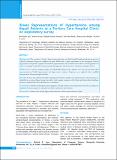Please use this identifier to cite or link to this item:
https://hdl.handle.net/20.500.14356/1515Full metadata record
| DC Field | Value | Language |
|---|---|---|
| dc.contributor.author | Sah, Ram Kishor | - |
| dc.contributor.author | Straus, Andrea | - |
| dc.contributor.author | Shrestha, Deepak Sundar | - |
| dc.contributor.author | Khanal, Hari Har | - |
| dc.contributor.author | Paudel, Bishnu Dutta | - |
| dc.contributor.author | Love, Richard R | - |
| dc.date.accessioned | 2023-05-15T05:30:03Z | - |
| dc.date.available | 2023-05-15T05:30:03Z | - |
| dc.date.issued | 2020 | - |
| dc.identifier.citation | SahR. K., StrausA., ShresthaD. S., KhanalH. H., PaudelB. D., & LoveR. R. (2021). Illness Representations of Hypertension among Nepali Patients at a Tertiary Care Hospital Clinic: An exploratory survey. Journal of Nepal Health Research Council, 18(4), 758-762. https://doi.org/10.33314/jnhrc.v18i4.2526 | en_US |
| dc.identifier.issn | Print ISSN: 1727-5482; Online ISSN: 1999-6217 | - |
| dc.identifier.uri | http://103.69.126.140:8080/handle/20.500.14356/1515 | - |
| dc.description | Original Article | en_US |
| dc.description.abstract | Abstract Background: The prevalence of stage 2 hypertension approaches one-third in adult Nepalis and despite inexpensive effective treatment, long-term compliance is poor. World-wide, a major impediment is the incongruity between hypertension and patients’ symptom-based illness representations. The Common-Sense Model of Self-regulation was used to investigate Nepali illness representations through open-ended interviews of patients with hypertension. Methods: In a tertiary hospital setting, 50 self-identified hypertensive patients were interviewed about their representations of health, hypertension, and hypertensive treatment. Responses were analyzed with a modified Interpretative Phenomenological Analysis. Results: An Ayurvedic-influenced health model appeared in illness identity and coping responses. Hypertension was identified as a serious disease having observable, wide-ranging symptoms with chronic and intermittent timelines. Concerns included side-effects and barriers to treatment. Conclusions: Further confirmation and investigation of Nepali common-sense hypertension models in a sample size sufficient for factor analysis is warranted for effective adherence interventions. Keywords: Common-sense model; hypertension adherence; illness representations; Nepal | en_US |
| dc.language.iso | en | en_US |
| dc.publisher | Nepal Health Research Council | en_US |
| dc.relation.ispartofseries | Oct-Dec, 2020;2526 | - |
| dc.subject | Common-sense model | en_US |
| dc.subject | Hypertension adherence | en_US |
| dc.subject | Illness representations | en_US |
| dc.subject | Nepal | en_US |
| dc.title | Illness Representations of Hypertension among Nepali Patients at a Tertiary Care Hospital Clinic: An exploratory survey | en_US |
| dc.type | Journal Article | en_US |
| local.journal.category | Original Article | - |
| Appears in Collections: | Vol. 18 No. 4 (2020): Vol. 18 No. 4 Issue 49 Oct-Dec 2020 | |
Files in This Item:
| File | Description | Size | Format | |
|---|---|---|---|---|
| 2526-Manuscript-28963-1-10-20220829.pdf | Fulltext Download | 217.91 kB | Adobe PDF |  View/Open |
Items in DSpace are protected by copyright, with all rights reserved, unless otherwise indicated.
